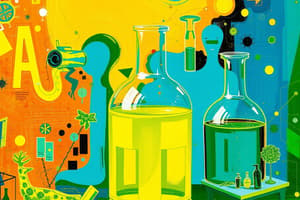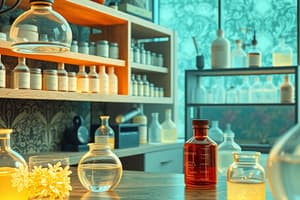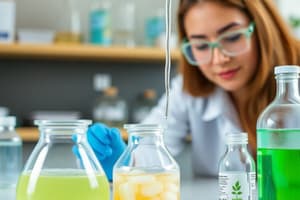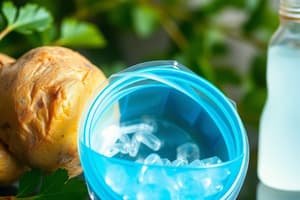Podcast
Questions and Answers
What is the primary role of glycerol in potato starch-based bioplastics?
What is the primary role of glycerol in potato starch-based bioplastics?
- To maintain the rigidity of the bioplastic
- To serve as a nutrient for bacteria
- To act as a plasticizer (correct)
- To increase the degradation rate of bioplastics
Which type of bacterial species is specifically mentioned as being capable of degrading bioplastics?
Which type of bacterial species is specifically mentioned as being capable of degrading bioplastics?
- Staphylococcus species (correct)
- Bacillus species
- Lactobacillus species
- Escherichia species
How does the presence of water influence the biodegradation of bioplastics?
How does the presence of water influence the biodegradation of bioplastics?
- It causes the bioplastics to harden.
- It slows down microbial activity.
- It has no effect on biodegradation.
- It serves as a medium for bacteria and microbes. (correct)
What is the primary source used to create traditional plastics?
What is the primary source used to create traditional plastics?
What is the effect of the HCl treatment in the production of potato starch-based bioplastics?
What is the effect of the HCl treatment in the production of potato starch-based bioplastics?
Which characteristic of potato starch contributes primarily to its brittleness?
Which characteristic of potato starch contributes primarily to its brittleness?
What is a common use for starch-based bioplastics?
What is a common use for starch-based bioplastics?
Which type of bioplastic is made from cellulose esters?
Which type of bioplastic is made from cellulose esters?
One major environmental concern with traditional plastics is that they:
One major environmental concern with traditional plastics is that they:
What is a primary characteristic of bioplastics compared to traditional plastics?
What is a primary characteristic of bioplastics compared to traditional plastics?
Flashcards
Biodegradation
Biodegradation
The natural breakdown of organic materials by microorganisms, sunlight, water, enzymes, and wind abrasion.
Biodegradable Plastics
Biodegradable Plastics
Plastics made from renewable resources like corn starch, which can be broken down by bacteria in the soil.
Photodegradable Plastics
Photodegradable Plastics
Plastics that break down when exposed to sunlight.
Amylopectin
Amylopectin
Signup and view all the flashcards
Glycerol's Role
Glycerol's Role
Signup and view all the flashcards
Bioplastics
Bioplastics
Signup and view all the flashcards
What makes bioplastics different from traditional plastics?
What makes bioplastics different from traditional plastics?
Signup and view all the flashcards
Why is this important?
Why is this important?
Signup and view all the flashcards
Starch-based bioplastics
Starch-based bioplastics
Signup and view all the flashcards
Types of Bioplastics
Types of Bioplastics
Signup and view all the flashcards
Study Notes
Prayer Before Class
- Holy Spirit, the source of light and wisdom, dispel darkness and ignorance.
- Grant a penetrating mind, retentive memory, and ease in learning.
- Guide the work, direct its progress, and bring success.
- Through Jesus Christ, living and reigning with the Father, forever Amen.
Post-Laboratory Discussion: Preparation of Biodegradable Plastics
- Chemistry for Engineers Laboratory at UST General Santos
Learning Objective
- Students will make a plastic film from potato starch.
PLASTICS
- Derived from crude oil (petroleum).
- Reliance on scarce fossil fuels.
- Burning releases carbon dioxide, contributing to global warming.
- Slow decomposition rates.
Decomposition Times of Various Materials
- Batteries: 110 years
- Vegetable leaves/branches: 1-6 months
- Food waste: 1 month
- News paper: >1 month
- Office paper: 2 years
- Wax paper: 5 years
- Stub filter: 2-3 years
- Chewing gum: 30 years
- Natural fabrics: 2-3 years
- Synthetic fabrics: 40-80 years
- Shoes (natural): 10 years
- Shoes (synthetic): 80 years
- Iron cans: 10 years
- Tin cans: 90 years
- Aluminium cans: 500 years
- Rubber tires: 120-140 years
- Glass: 1000 years
- Polyethylene bags/plastic bottles: 100-200 years
- Baby diapers: 200-500 years
What are BIOPLASTICS?
- Form of plastic derived from renewable biomass sources (vegetable oil or corn starch).
Types of Bioplastics
- Starch based: Made from natural starch, used in packaging and drug capsules.
- Cellulose based: Made from cellulose esters, used in thermoplastics and packaging.
- Protein based: Made from proteins (soy or wheat), used in car body panels.
- Some aliphatic polyesters: Other types
Characteristics of Bioplastics vs. Petroleum-based Plastics
| Feature | Bioplastics | Petroleum-based Plastics |
|---|---|---|
| Energy Consumption | 48% lower | High |
| Raw Materials | Biomass (starch, sugarcane, etc.) | Petroleum (non-renewable resource) |
| Carbon Footprint | Lower (62% less CO2 emission) | Higher |
| Presence of Toxic Chemicals | None (BPA-free) | Potential presence of Bisphenol A (BPA) |
| Physical Properties | Stable, thermoplastics properties | Highly stable, thermoplastic properties |
| Biodegradability | Decompose in 180 days (faster) | >1000 years (slower) |
BIODEGRADABILITY
- Biodegradation is the breaking down of organic materials through natural processes (sunlight, water, bacteria, enzymes, wind).
Biodegradation of Bioplastics
- Breakdown by bacteria found in the soil (Pseudomonas, Streptococcus, Staphylococcus).
- Potato starch polymer chain breakdown by bacteria.
- Glycerol water absorption increases bioplastic degradation.
Degradable Plastics Types
- Biodegradable: Contain a small percentage of non-oil-based material (like corn starch).
- Photodegradable: Break down when exposed to sunlight.
Potato Starch
- Polymer made of linked glucose units.
- Contains two carbohydrate polymers: Amylose (long-chain) and Amylopectin (highly branched).
Potato Starch Based Bioplastic
- HCI breaks down amylopectin for film formation.
Purpose of Adding Glycerol
- Amylose is brittle; glycerol increases flexibility and elasticity.
- Glycerol disrupts hydrogen bonds, weakens starch structure, and enhances flexibility.
- Glycerol is hygroscopic (absorbs moisture) further improving bioplastic properties.
End of Discussion
Studying That Suits You
Use AI to generate personalized quizzes and flashcards to suit your learning preferences.




